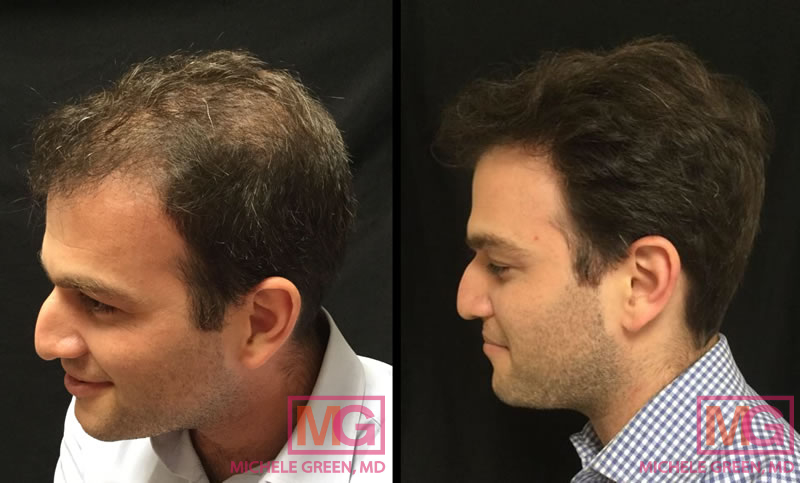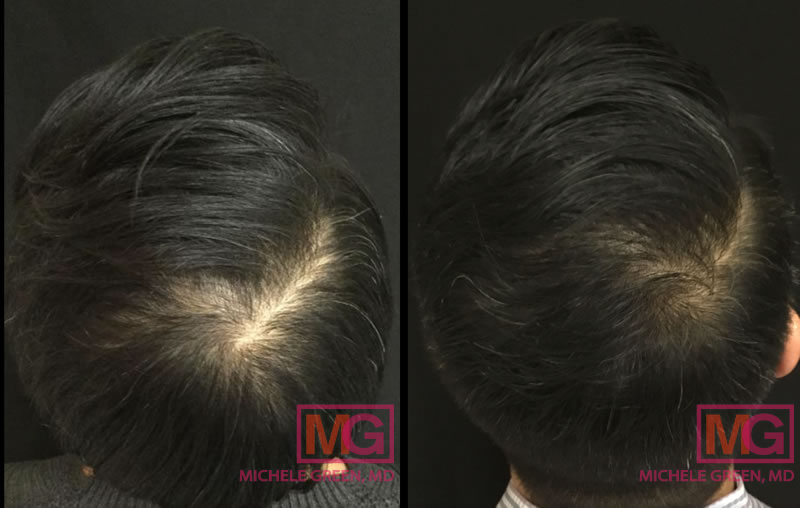Can You Continue Rogaine After Prp
What is PRP Hair Restoration & How Does It Work?
PRP (platelet-rich plasma) is a hair restoration treatment that has become very popular in the past few years. The way PRP works is simple: the patients' own blood is drawn, the blood then gets spun in a centrifuge to separate the plasma from the red blood cells and other blood components. The plasma contains important the growth factors and proteins that are used to help with tissue repair and wound healing. Generally, PRP therapy is commonly known for its use as a hair restoration treatment as it helps stimulate an increased hair growth, producing new hair and thickening existing thinning hair. PRP is replete with stem cells which makes hair rejuvenation possible. The platelet rich plasma is then injected into the treated area of the scalp, treating both androgenic alopecia and female pattern baldness. Since there are no side effects or downtime from PRP injections, its safety and effectiveness have made it a very popular procedure for hair loss in NYC. PRP has a proven track record in other areas, not just for hair loss in dermatology. For example, it has been used to aid the healing of other areas of the body, such as joints, tendons, ligaments and muscles.
What Does Platelet Rich Plasma Consist Of?
Platelet rich plasma consists of a myriad of growth factors. Specifically, the prominent growth factors include platelet-derived growth factor (PDGF), transforming growth factor (TGF), vascular endothelial growth factor (VGEF), epidermal growth factor (EGF), insulin-like growth factor (IGF), and fibroblast growth factor (FGB), amount others. Since the platelets are filled with growth and healing factors, platelets initiate repair and augments stem cells to repair and increase the body's own natural healing.
Which Hair Loss Patients Can Benefit From PRP Treatments?
PRP hair restoration is suitable for both men and women. If you are suffering from hair loss, hair thinning, or premature balding, then you are a good candidate for PRP injections. As some types of hair loss result from a decrease in the amount and density of hair follicles, platelet-rich plasma therapy is a wonderful hair loss treatment which can aid with hair regrowth. PRP can help to reverse the process which occurs in androgenetic alopecia (male pattern baldness or female pattern hair loss). Patients who have experienced hair loss, thinning hair, or suffer from alopecia areata (an autoimmune type of hair loss) may be good candidates who can benefit from PRP.
In addition to PRP, there is also hair transplantation, which is a surgical procedure for more severe hair loss. Hair transplantation involves removing hair follicles from the posterior scalp and transplanting them to areas of the scalp in which hair follicles are absent. A hair transplant works best for those patients that have more areas of baldness, whereas PRP works best to promote hair growth in areas where the hair follicles are not completely damaged.
Can You Wash Your Hair After PRP Treatments?

Some of the common questions related to PRP have to do with after-care and what you should do once you've undergone the treatment. One question that is regularly asked is whether you can wash your hair after having PRP treatments. Our recommendations here is that you should wait until the following day after the procedure to wash your hair. Shampoo can also be used on your head the next day after your treatment. The main reason to refrain from washing your hair 24 hours after the treatment is undertaken is the risk of impacting your PRP treatment. We also advise patients not to exercise on the day of the PRP treatment. Like shampooing, exercise can also be resumed the day after your PRP injections.
What Other Precautions Should I Take?
There are some other precautions that you should take once you've had your PRP hair treatment. For example, you should avoid taking blood thinners such as aspirin, Motrin, ibuprofen and anti-inflammatory medications. Tylenol is safe to take if you do experience discomfort after the treatment. Avoid alcohol and smoking for at least three days after you've had a PRP session.
Dr. Michele Green may also suggest using topical minoxidil (Rogaine) or finasteride (Propecia) alongside PRP since this can sometimes achieve fuller, and quicker results than PRP treatments alone.
What Happens With PRP Longer Term?
Longer term you'll need to have additional treatments every three to six months. This may be stretched to a year depending on your own individual situation and how you react to the PRP sessions. The results of PRP vary and we have seen that many people typically need four or five PRP treatments set a month apart initially to see new hair growth.

Find out more about PRP for Hair Loss
Dr. Michele S. Green, a board-certified dermatologist based in NYC, practices the latest techniques in hair loss to give you the look that you deserve. To learn morecontact us online today or call212-535-3088.
weberentrught1943.blogspot.com
Source: https://www.michelegreenmd.com/can-i-wash-my-hair-after-prp-treatments
0 Response to "Can You Continue Rogaine After Prp"
Post a Comment